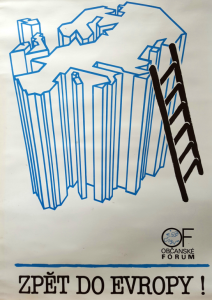Back to Europe
Sadakat Kadri
Three weeks after the Berlin Wall opened up on 9 November 1989, I made my way from London to Prague, anxious to catch a revolutionary wave that seemed about to ebb. Within days, I had decided to stay. I was 25. A publishing company, tentatively imagining that a few adventurous Westerners might one day explore Europe’s post-Communist wastelands, offered me a pittance to write a guidebook. It was a deal too good to refuse, and three years of pen-chewing ensued. But writing was never the priority. The city was a party.
It’s more sober memories that have been rekindling of late, however. Europe in 1989 still embodied compromises struck after the Second World War, and with the ideological divisions marked by barbed-wire borders, change was almost inconceivable. Bartek Konopka and Piotr Rosołowski captured that illusory sense of permanence in their 2010 documentary about the rabbits of the Berlin Wall. In the mid-1980s, visiting Eastern Europe for the first time, I had seen dozens of bunnies nibbling contentedly along the death strip, but as the night train trundled towards Prague in December 1989, there wasn’t a single rabbit in the searchlight beams. After three decades of deathly calm, the Wall was under a 24-hour assault from mallets, pile-drivers and bulldozers – but even in 1989, I sympathised with the rabbits’ discombobulation. Ways of life taken for granted across Europe were going to change no less unpredictably.
Unpredictability spirals in any number of directions, though, and it’s always worth thinking about the reasons events went the particular way they did. The people demonstrating against Communism in Prague in 1989 had one aspiration above all others, and rummaging recently through my souvenirs, I found its visual expression: a ladder leaning against a raised map of the continent, over the words ‘zpĕt do Evropy!’: ‘Back to Europe!’ The slogan propelled Václav Havel to the presidency by the end of December, and inspired him two years later to host the meeting that dissolved the Warsaw Pact. The Czech Republic and Slovakia separated peacefully in 1993, and 11 years after that, both joined the European Union.
The EU’s role over the last 27 years has hardly been heroic. Quite apart from its bloat and unaccountability, the diplomatic posturing of its many organs has often been counter-productive – arguably accelerating Yugoslavia’s civil war in the early 1990s, for example, and provoking Russian aggression more recently in Ukraine. It has shown itself incapable of resolving the current migrant crisis, and nationalists everywhere have exploited its failure.
I still can’t believe, however, that Europe would have pulled through the last 27 years without the EU. Counterfactual hypotheses are impossible to prove, but one peculiarity of English nationalism is that European history is routinely portrayed as a subplot to our island story. The convulsions that divided Europe between 1945 and 1989 are merely a messy postscript to the Second World War – which was all about Dunkirk, Spitfires and standing alone, anyway.
Brexiteer politicians have not only appealed to nostalgia for a time when old maids drank warm beer as they cycled across misty cricket grounds, but also conjured a dynamic global future: a UK plc, which, freed from the shackles of Brussels, will negotiate brilliant free-trade deals (excluding migrant workers) and re-embrace a grateful Commonwealth. These fantasies are dangerously unrealistic, but the bluster has also eclipsed the EU’s role in stitching our continent back together. No one knows what the future holds, and even if we leave, I hope the EU will thrive without us. When I look at my poster though, I can’t help but feel a little ashamed that a generation on from 1989, we’ve come so close to climbing out.
